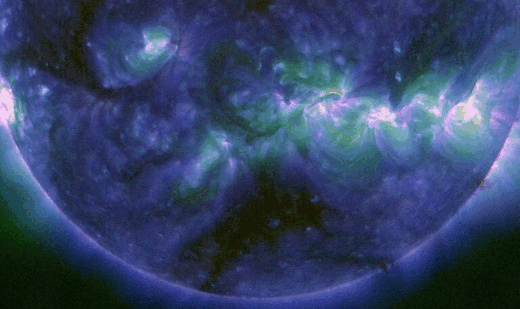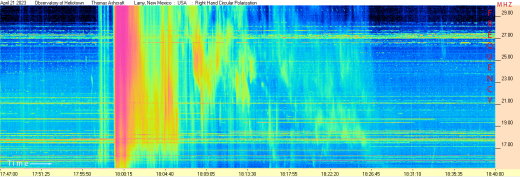An Earth-Directed Explosion on the Sun
DR.TONY PHILLIPS

April 21, 2023: Earth is in the strike zone. On April 21st, a large magnetic filament snaking across the sun’s southern hemisphere exploded, hurling a cloud of debris in our direction. This movie from NASA’s Solar Dynamics Observatory shows what happened:

Soon after the eruption, the US Air Force reported strong Type II and Type IV solar radio bursts. These are natural shortwave emissions produced by shock waves preceding the CME as it passes through the sun’s atmosphere. Drift rates in the Type II burst suggested a CME velocity of about 580 km/s (1.3 million mph).
Images from SOHO coronagraphs have since confirmed the CME. It is a “halo CME” heading straight for Earth:

Models from NASA and from NOAA agree: the CME should reach Earth during the early hours of April 24th between the hours of 00:00 and 12:00 UT. The impact could spark G1- (Minor) to G2-class (Moderate) geomagnetic storms, with a slight chance of G3 (Strong). Aurora alerts: SMS Text.
A BURST OF STATIC FROM THE SUN: The explosion that hurled a CME toward Earth on April 21st also illuminated our planet with an intense burst of shortwave radio static. Amateur astronomer Thomas Ashcraft of New Mexico recorded the outburst:

“Few solar radio bursts show as hot purple on my spectrograph, but this one ‘rang the bell’,” he says. “Here is an audio recording in stereo with 22 MHz in one channel and 19 MHz in the other.”
The static in Ashcraft’s recording, which washes over the listener like a slow ocean wave, is naturally produced. Astronomers classify it as a Type V solar radio burst caused by energetic beams of electrons ray-gunning through the sun’s atmosphere. The electrons were accelerated by the same underlying explosion that hurled a CME toward Earth.
Solar radio bursts are an underappreciated form of space weather. We often talk about radio blackouts, which happen when solar flares ionize the top of Earth’s atmosphere. A radio blackout suppresses the normal propagation of terrestrial radio signals. Solar radio bursts, on the other hand, produce a radio drownout. Intense static from the sun overwhelms normal transmissions, drowning out the voices radio operators are trying to hear.
Solar radio bursts will happen more and more often as Solar Cycle 25 intensifies. You can hear them youself using a RadioJOVE radio telescope kit from NASA.
___
https://spaceweatherarchive.com/2023/04/23/an-earth-directed-explosion-on-the-sun/
